Gigabyte R182-Z93 Bruksanvisning
Läs gratis den bruksanvisning för Gigabyte R182-Z93 (146 sidor) i kategorin Server. Guiden har ansetts hjälpsam av 7 personer och har ett genomsnittsbetyg på 4.8 stjärnor baserat på 4 recensioner. Har du en fråga om Gigabyte R182-Z93 eller vill du ställa frågor till andra användare av produkten? Ställ en fråga
Sida 1/146

R182-Z93
AMD EPYC™ 7003 DP Server System - 1U 10-Bay Gen4 NVMe
User Manual
Rev. A00
Produktspecifikationer
| Varumärke: | Gigabyte |
| Kategori: | Server |
| Modell: | R182-Z93 |
| Färg på produkten: | Meerkleurig |
| Vikt: | 1301.5 g |
| Bredd: | 438 mm |
| Djup: | 43.5 mm |
| Höjd: | 730 mm |
| Förpackningens vikt: | 1473 g |
| Förpackningens bredd: | 385 mm |
| Djuppackning: | 190 mm |
| Förpackningshöjd: | 284 mm |
| Strömförsörjning: | 1200 W |
| LED-indikatorer: | HDD, LAN, Status |
| Rekommenderad ålder (min): | 4 jaar |
| Typ av förpackning: | Gesloten doos |
| Processorfamilj: | AMD |
| Ursprungsland: | Duitsland |
| Tullproduktkod (TARIC): | 95030070 |
| Batteri/Batterispänning: | 1.5 V |
| Antal batterier/batterier som stöds: | 2 |
| Material: | Kunststof |
| Rekommenderad användning: | Binnen |
| Föreslaget kön: | Jongen/meisje |
| Batterier krävs: | Ja |
| Trusted Platform Module (TPM): | Ja |
| Nettovikt kartong: | 2603 g |
| Master (yttre) box förpackningstyp: | Doos |
| Antal bitar: | 77 stuk(s) |
| Figur medföljer: | Ja |
| Montering krävs: | Nee |
| (Ytter) huvudpaketets höjd: | 395 mm |
| (Ytter) huvudförpackningens bredd: | 390 mm |
| (Ytter) huvudförpackningens bruttovikt: | 2603 g |
| (Ytre) huvudpaketets längd: | 290 mm |
| Kvantitet per (yttre) huvudkartong: | 2 stuk(s) |
| Palls bruttovikt: | 103296 g |
| Antal processorer som stöds: | 2 |
| Antal lagringsenheter som stöds: | 11 |
| Minnestyper som stöds: | DDR4-SDRAM |
| Batterier-ingår: | Nee |
| Förpackningsmaterial: | Doos |
| Batterityp: | AAA |
| Pall bruttohöjd: | 1730 mm |
| Pallboskapsras: | 1200 mm |
| Pall bruttolängd: | 800 mm |
| Lagen per pallet: | 4 stuk(s) |
| Antal (yttre) huvudpaket per pall: | 32 stuk(s) |
| Antal lådor per palllager: | 8 stuk(s) |
| GTIN (EAN/UPC) nummer (yttre) huvudförpackning: | 4008789794703 |
| Antal paket: | 1 |
| Nettoviktspall: | 83296 g |
| Pall nettobredd: | 1200 mm |
| Pall nätdjup: | 800 mm |
| Pallnätshöjd: | 1580 mm |
| EU TSD-varning: | Niet geschikt voor kinderen onder de 36 maanden |
| Minimum antal: | 2 stuk(s) |
| Beställningsbar vara: | Nee |
| Faktureringsenhet: | Ja |
| Manuella språk (ISO 639-format): | BUL, CZE, DAN, DEU, EST, GRE, ENG, ESP, FRE, IRL, CRO, ITA, LAT, LIT, HUN, MAL, DUT, POL, POR, ROM, SLV, FIN, SWE, RUS, CHI |
| Typ av kommersiell enhet: | Klant enkele eenheid |
| Tillgänglig från: | 01-01-2019 |
| Importland (ISO 3166-1): | Duitsland |
| Fraktenhet: | Nee |
| Förpackningsprover (ISO 639-format): | BUL, CZE, DAN, DEU, EST, GRE, ENG, ESP, FRE, IRL, CRO, ITA, LAT, LIT, HUN, MAL, DUT, POL, POR, ROM, SLV, FIN, SWE, RUS, CHI |
| Pallfaktureringsenhet: | Nee |
| Pall typ: | 800 x 1200 mm |
| Master (yttre) box faktureringsenhet: | Nee |
| Master (yttre) box beställningsbar enhet: | Nee |
| Master (yttre) fraktenhetslåda: | Nee |
| Pallbeställningsbar enhet: | Nee |
| Pallfraktenhet: | Ja |
| Pallkonsumentenhet: | Nee |
| Minsta beställningskvantitet för masterbox (yttre).: | 2 stuk(s) |
| Pall minsta beställningskvantitet: | 64 stuk(s) |
| (cdm) "Reconducted" ny nedgång: | Opnieuw uitgevoerd (reconducted) |
| Säsong: | Permanent, Year End |
| Ekoförpackning: | Ja |
| (cmd) beställningskvantitet multipel: | 2 |
| Konsumentenhet: | Ja |
| (cdm) Är accessoar: | Speelgoed |
| Master (yttre) box konsumentenhet: | Nee |
| Låddjup: | 588 mm |
| Vikt inkl. förpackning: | 22000 g |
| processortillverkare: | AMD |
| Inbyggd processor: | Nej |
| Typ av ethernet-gränssnitt: | Gigabit Ethernet |
| Datahastighet för Ethernet-LAN: | 10,100,1000 Mbit/s |
| Antal LAN (RJ-45) anslutningar: | 2 |
| Temperatur vid drift: | 10 - 35 ° C |
| Temperaturintervall (förvaring): | -40 - 60 ° C |
| Intervall för relativ operativ luftfuktighet: | 8 - 80 % |
| Fuktighet (förvaring): | 20 - 95 % |
| processorsockel: | Socket SP3 |
| AC-inspänning: | 100 - 240 V |
| Nätverksansluten (Ethernet): | Ja |
| Växelström Frekvens: | 50 - 60 hz |
| Minneskanaler: | Åtta kanaler |
| LAN-styrenhet: | Intel® I350-AM2 |
| Antal M.2 (M)-platser: | 1 |
| Harmonized System (HS)-kod: | 84714100 |
| Förpackningarnas innehåll: | 1 x R182-Z93\n2 x CPU heatsinks\n1 x Rail kit |
| Kvalitet på VGA (D-Sub) porten: | 1 |
| PCI Express-kortplatser version: | 4.0 |
| Ombord grafikkort modell: | Aspeed AST2500 |
| Diskret grafikkortsmodell: | Ej tillgänglig |
| Trusted Platform Module (TPM)-version: | 2.0 |
| Chassityp: | Rack (1U) |
| Antal 2,5 "vikar: | 10 |
| Antalet DIMM-platser: | 32 |
| Som stöds DIMM-modul kapacitet: | 16GB, 32GB, 64GB, 128GB |
| Hårddisk hot swap: | Ja |
| Antal COM portar: | 1 |
| PCI Express x16 platser: | 4 |
| Antal huvudnätaggregat: | 2 |
| Stöd för RDIMM klockfrekvenser: | 2933,3200 MHz |
| Bakplan stöder: | Ja |
| Likspänning ut (+12 V): | 97 A |
Behöver du hjälp?
Om du behöver hjälp med Gigabyte R182-Z93 ställ en fråga nedan och andra användare kommer att svara dig
Server Gigabyte Manualer
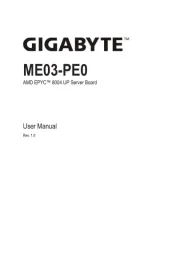
11 Augusti 2025
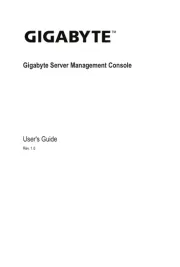
11 Augusti 2025
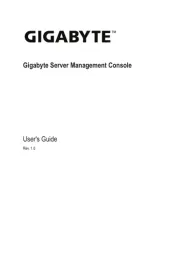
10 Augusti 2025
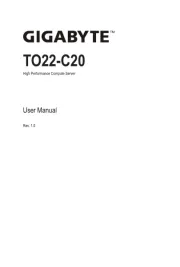
10 Augusti 2025
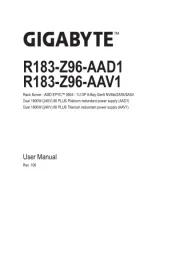
10 Augusti 2025
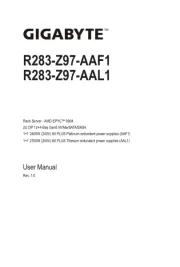
10 Augusti 2025
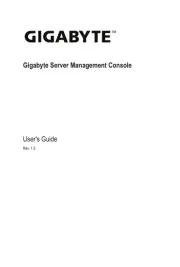
10 Augusti 2025
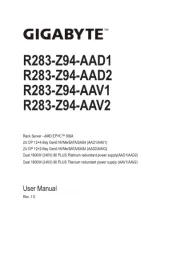
10 Augusti 2025
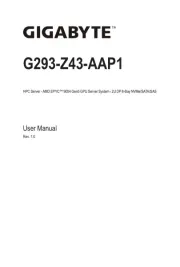
10 Augusti 2025
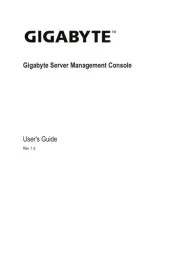
10 Augusti 2025
Server Manualer
- QNAP
- Kramer
- IStarUSA
- Moxa
- Western Digital
- Sonnet
- Revox
- Sitecom
- Tripp Lite
- Valcom
- Ibm
- In Win
- Digi
- Technics
- Promise Technology
Nyaste Server Manualer
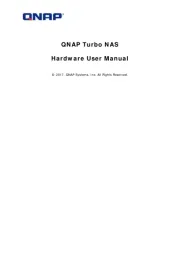
20 Oktober 2025

19 Oktober 2025

19 Oktober 2025

19 Oktober 2025

19 Oktober 2025
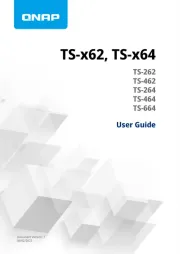
19 Oktober 2025
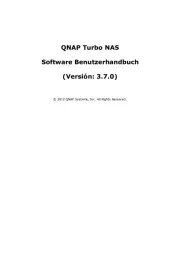
16 Oktober 2025
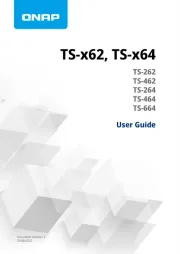
16 Oktober 2025
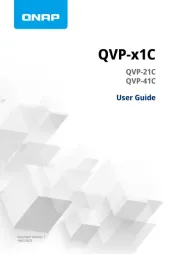
16 Oktober 2025

16 Oktober 2025